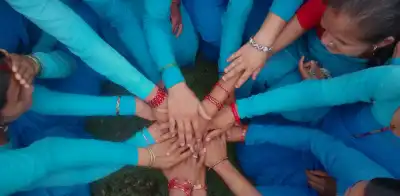This is Part One of a two-part series featuring the global NGO Light for the World.
Part Two: Leading Teams and Lighting the Way with OKRs
Summary
Eva Hammer, OKR Shepherd for global NGO Light The World, facilitated the roll-out of OKRs across several countries in the midst of a global pandemic. Learn how she countered initial skepticism and used OKRs to help a globally-dispersed nonprofit come together and thrive.
For Eva Hammer, shepherding the OKRs for a global NGO demands creativity, empathy, and persistence. This is not daunting for Hammer, who actively cultivates all three in a weekly philosophy class she takes with friends. She chooses to relax by chewing on Really Big Ideas, in part, because studying philosophy has made her adept at separating “the really important from the less important.” A valuable skill when you are asked to keep your nonprofit focused on what matters — through Objectives and Key Results (OKRs).
Hammer is an OKR master and head of controlling and reporting at Light for the World, which operates in 15 countries for the inclusion and economic empowerment of people with disabilities. From Bolivia to Burkina Faso, the nonprofit advocates for disability rights and provides people in rural and hard-to-reach regions with eye health services, training in and access to inclusive education, and tools and resources for independent living.
Like many international NGOs and nonprofits, Light for the World measures progress and impact with MERLA: Monitoring, Evaluation, Learning, Research, and Adapting. MERLA components are critical to shaping strategy, determining the “what” that underlies Light for the World’s “why,” breaking down barriers to enrich society and unlock the potential in all of us. OKRs let this nonprofit bring the “how” of its large-scale mission into sharper focus.
Introducing OKRs at a nonprofit
Light for the World made the important early decision to designate an OKR Shepherd or master, who cultivates expertise, designs and oversees the organization-wide OKR process, and provides tools and training for others. Hammer brings both a deep and a broad understanding of the organization; she has spent time in programs and grants management and, in her current role in financial planning, sees how OKRs connect to resource allocation. Through her philosophical practice, she has honed the ability to seek out and incorporate a variety of perspectives and the ability to work a problem from many angles.
Hammer was introduced to OKRs in late 2019 by her boss, Daniel Frieß, who recommended she read Measure What Matters and began introducing OKRs to the leadership team at Light for the World. The nonprofit had tried various approaches to goal-setting over the years, but found OKRs appealing for their simple logic and quarterly rhythm — a great fit for their dynamic operating environment. The leadership team also saw how the prioritization, transparency, and collaboration that emerge from OKRs could contribute to a desired culture shift: developing leadership strength across the entire organization.
Launching OKRs at a nonprofit, which may be less familiar with methodologies used in the corporate world, can come with challenges. When the leadership team sat down in early 2020 to define its first OKR set, Hammer and other leaders first needed to get buy-in. There were those who thought OKRs might be burdensome or just another version of something they’d already tried and discarded. There were even a few who saw OKRs as a means of control rather than as a tool for focus and empowerment.
“We were met with some initial skepticism,” notes Hammer. It took three weeks to reach agreement on those first organizational OKRs. “While frustrating at first, it actually helped that people reacted emotionally and were honest,” says Hammer. “We could then make sure everyone had a chance to share feedback, and we learned where we needed to communicate better to reduce fear. We also took the pressure off by reminding people that this would be a learning journey for all of us and one that would get easier over time.”
Light for the World was just building momentum when everything changed in March 2020. In that quarter, the NGO expected, among other things, to be expanding eye health programs that support the training of ophthalmic technicians and opthamologists in sub-Saharan Africa. Amid the COVID-19 pandemic, they had to immediately re-prioritize to meet new challenges, creating a set of OKRs to kick-start COVID-19 response programs.
As everyone grew more used to operating in a COVID-19 environment, selected teams piloting OKRs continued to develop OKRs for Q3 that focused on activities more aligned with the main mission. They used Q4 to evaluate their OKRs and take stock of what they had learned; the next step would be to roll them out to the teams working in offices around the globe, known as country offices.

Launching OKRs with a globally dispersed team
Here too, Hammer faced some initial resistance. “People were scared that OKRs were primarily a tool to measure individual performance or that they added too much additional reporting,” she says. To make OKRs more accessible to this geographically dispersed team, Hammer linked her lessons to the people Light for the World serves. She created a comprehensive playbook that weaves in the stories of:
- Oscar, who started his own business in Uganda building doors and windows for others in wheelchairs;
- Kassie, an 8-year-old Ethiopian boy whose surgery made it possible to walk, go to school, and play with friends;
- Rabeca, a 70-year-old woman in Mozambique now able to cook and take care of her field, thanks to cataract surgery.
Oscar. Kassie. Rabeca. “They are the reason we are here,” says Hammer.
The nonprofit’s OKR playbook includes a full glossary of terms and an outline of roles and responsibilities, including how Hammer, as OKR master, works with and supports a team of country coaches — designated OKR guides in each office.
Things began to shift when country office teams realized OKRs would actually make their work more manageable. For one thing, they have the opportunity to review organizational OKRs before finalization. This lets them weigh in on how the priorities coming from the international office support or potentially hinder their work. They have also discovered a valuable flip side to identifying clear quarterly priorities, and that is the opportunity to explicitly identify any projects that are NOT a priority for that cycle.
Building goal-setting skills with OKRs
In March 2021, one year into the process, that Hammer knew they had turned a corner. This time, it took the leadership team three hours rather than three weeks to define their OKRs. And when the country offices responded to leadership OKRs and began setting their own, people were asking questions that showed how seriously they were taking the process. Questions like: Is what we’re planning to do really in line with the strategy, or are we off track? Is an OKR really in our control, or do we actually need support or input from others? How can we make sure we have sufficient resources available to conduct routine tasks? “All of these lead discussion and solution identification in the right directions and toward better collaboration,” says Hammer.
She now also has champions in the field, like Sophia Mohammed, country director in South Sudan. “Knowing that we have priorities and that anything beyond those will be addressed in another quarter, gives our team some relief,” Mohammed says. “And we can see even more directly how we are improving in the quality of what we do and how that connects to our impact.” Hammer notes that OKRs also make the work of the country offices more visible to the rest of the organization.
“People are getting more and more motivated to make progress and achieve results. They are speaking up, providing feedback on organization-wide OKRs, and feeling more valued,” says Hammer. “I have seen OKRs trigger the kinds of attitudes that strengthen an organization — and strengthen it from the bottom-up.” Now that is a Really Big Idea.
This is Part One of a two-part series featuring the global NGO Light for the World.
Part Two: Leading Teams and Lighting the Way with OKRs
If you’re interested in starting our OKRs 101 course, click here.



